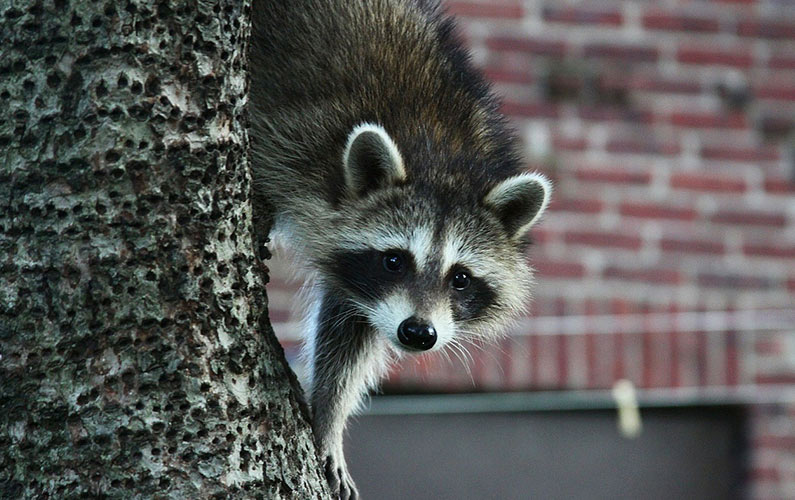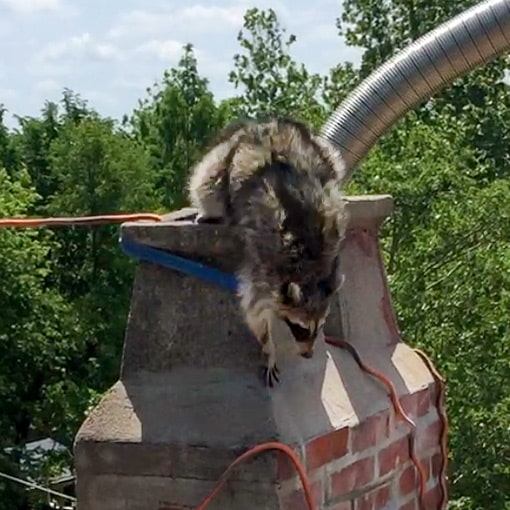Raccoons in chimneys and fireplaces are a common issue reported by homeowners.
To us, a chimney is an excellent resource for warmth and comfort. But to a momma raccoon, it is the perfect venue for raising a family. Raccoons choose chimneys because they are dark, warm, and isolated from predators, similar to a hollow tree found in the wilderness! Unless you enact removal measures, the mother will keep the babies there until they’re old enough to climb, fight, and eat solid food.
While these critters are objectively cute and mean no harm, allowing them to live rent-free in your unit is costly and dangerous for you AND them. Learn how to stop raccoon in chimney problems permanently by reading through this blog!
Video: Mother and Babies Family of Raccoons caught on our high-definition chimney inspection cameras at a customers home.
How to Get Rid of Raccoons in Your Fireplace
According to the Humane Society of the United States, if you’re 100% certain that they’re primarily adult raccoons, try utilizing these humane removal techniques:
-
- Timing: Raccoons are the most active at night, so you should pursue removal measures around dusk.
- Sounds: Loud noises could scare out raccoons in chimneys. Try playing loud music or talk radio inside the fireplace, or lightly bang on the damper plate with a broomstick.
- Lights: Try shining bright lights inside the chimney from the top.
- Smells: Placing unpleasant odors near the damper is a proven way to scare off raccoon infestations. Use odors such as sprinkles of coyote urine on a washcloth or a bowl of vinegar or ammonia.
Never attempt to use fire, smoke, or chemicals to get rid of raccoons in chimneys. These methods are ineffective and could kill the animals.
If there are baby raccoons in the chimney, you must call a professional wildlife control company to remove them for you.
Removing raccoon families is extremely risky to the untrained homeowner. In most cases, you’ll have to remove the babies by hand, which puts you at risk of diseases. And if the mother is still in the chimney, she’ll likely attack you to protect her young! You also run the risk of inadvertently permanently separating them from their mother or, even worse, killing them.
If you’re not willing to hire a professional, you’re in luck; there is another option.
Image shows a raccoon exiting the flue
Will Raccoons Leave on Their Own?
Yes, raccoons will eventually leave your chimney system on their own; however, you will need to exercise great patience.
A significant reason raccoon mothers choose chimneys as a nursery is because their babies can’t climb or run until they’re around six weeks old. It provides ample warmth and protection for them until the eighth or ninth week, where they can safely travel outside with their mother.
Once they reach this point, the family will make their way out with a low possibility of returning. Keep reading to learn how to prevent this from happening in the future!
Cost to Remove Raccoon from Chimney
According to Fixr.com, the average cost to remove raccoons in chimneys is $300-$500. Of course, prices vary depending on various factors.
Capturing an adult raccoon requires a specialized trap that mounts on top of the flue tile. It safely contains the critter when it roams outside in search of food.
If there are babies, the professional will attempt to remove them by hand after containing the mother; however, it requires additional specialized equipment if that’s not an option. Unfortunately, your bill will increase, but it’s the best way to ensure the safety of these innocent animals.
The next step is to call a certified chimney sweep to inspect and clean your system. The sweep will clean the leftover debris and identify any necessary repairs.
How to Keep Animals Out for Good
The best way to keep raccoons, birds, bats, and other animals out of your chimney is to install a stainless-steel chimney cap.
While no two chimneys are the same, when it comes to raccoons in chimneys, they almost always have one thing in common, a missing or damaged cap.
A cap is a protective “hat” that sits on top of your unit and is essential to a well-functioning venting system. It’s essentially like hiring a lifetime bodyguard that keeps nasty elements such as animals, debris, and carbon monoxide out and assists in proper drafting.
Image shows a Full Service Chimney™ technician installing a stainless steel cap
Summary
Raccoons reside in urban chimneys because it’s a safe place to raise their young. And while they’re generally innocent creatures, they prevent you from safely utilizing your system and could cause costly damages.
There are various practical and humane techniques to scare off raccoons in chimneys if they’re all adults. But, especially if babies are involved, the best way to guarantee the safety of the raccoons and your chimney system is to hire professionals.
If you suspect raccoons in your chimney, call an animal control company and your local chimney sweep as soon as possible. It will save you a lifetime of furry headaches and stress!



